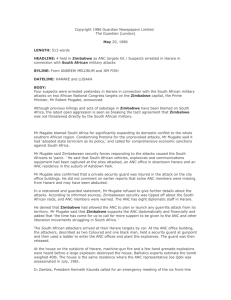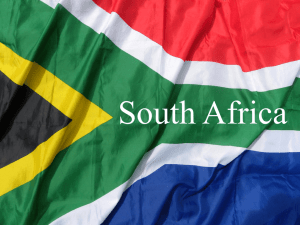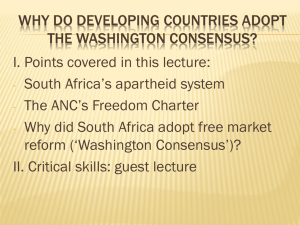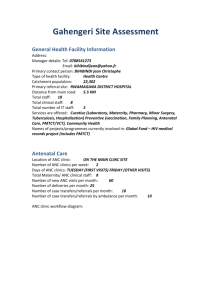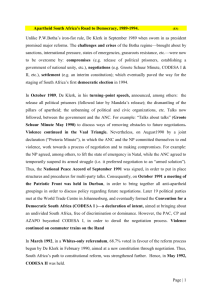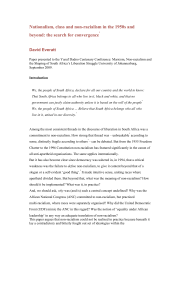The ANC*s First Newspaper Recovered
advertisement
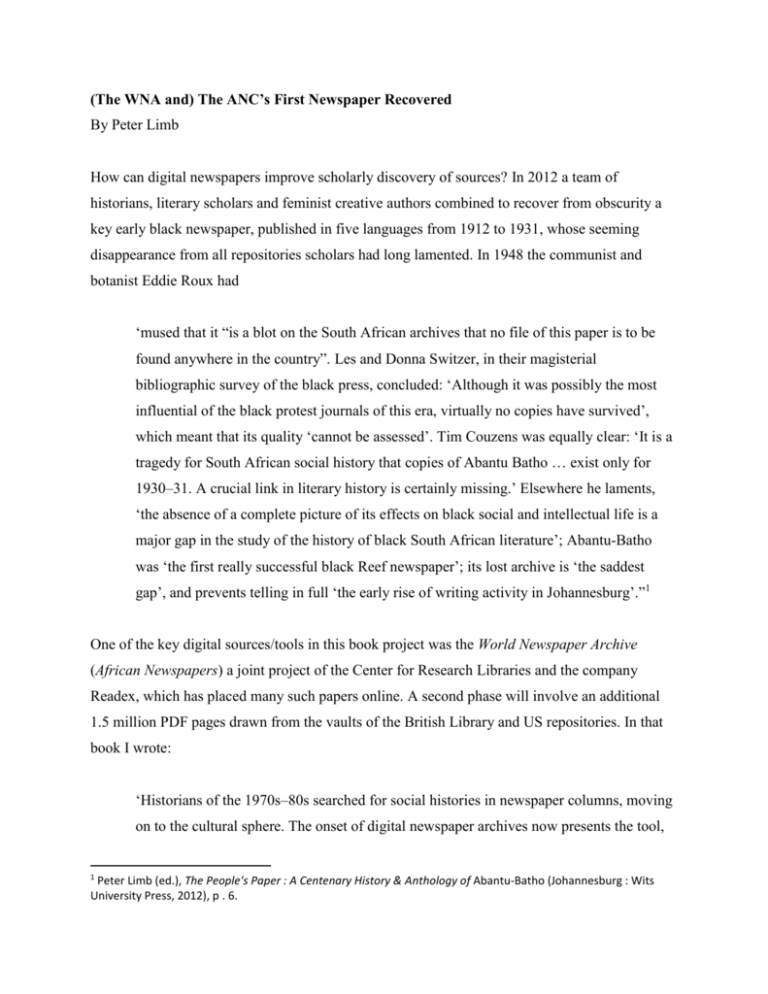
(The WNA and) The ANC’s First Newspaper Recovered By Peter Limb How can digital newspapers improve scholarly discovery of sources? In 2012 a team of historians, literary scholars and feminist creative authors combined to recover from obscurity a key early black newspaper, published in five languages from 1912 to 1931, whose seeming disappearance from all repositories scholars had long lamented. In 1948 the communist and botanist Eddie Roux had ‘mused that it “is a blot on the South African archives that no file of this paper is to be found anywhere in the country”. Les and Donna Switzer, in their magisterial bibliographic survey of the black press, concluded: ‘Although it was possibly the most influential of the black protest journals of this era, virtually no copies have survived’, which meant that its quality ‘cannot be assessed’. Tim Couzens was equally clear: ‘It is a tragedy for South African social history that copies of Abantu Batho … exist only for 1930–31. A crucial link in literary history is certainly missing.’ Elsewhere he laments, ‘the absence of a complete picture of its effects on black social and intellectual life is a major gap in the study of the history of black South African literature’; Abantu-Batho was ‘the first really successful black Reef newspaper’; its lost archive is ‘the saddest gap’, and prevents telling in full ‘the early rise of writing activity in Johannesburg’.”1 One of the key digital sources/tools in this book project was the World Newspaper Archive (African Newspapers) a joint project of the Center for Research Libraries and the company Readex, which has placed many such papers online. A second phase will involve an additional 1.5 million PDF pages drawn from the vaults of the British Library and US repositories. In that book I wrote: ‘Historians of the 1970s–80s searched for social histories in newspaper columns, moving on to the cultural sphere. The onset of digital newspaper archives now presents the tool, 1 Peter Limb (ed.), The People's Paper : A Centenary History & Anthology of Abantu-Batho (Johannesburg : Wits University Press, 2012), p . 6. as John Nerone says, to begin ‘the reconstruction of the national conversation of previous ages’, aided by the distributed nature of the press via the recirculation of content through reprinting in other periodicals or by exchange, which may have been more useful in generating a national profile than subscribers. This is one way Abantu-Batho is now emerging from archival obscurity. Just as close monitoring by opponents gave it some credibility, the reprinting of content and its exchange to editors in other places, and the ability to search some of this contentonline has helped us recover more of this hidden archive’.2 Stephanie Newell used similar sources and tactics to help write her most interesting book on anonymity in the West African press.3 The brief journalistic article below was commissioned for and published in The Thinker (Johannesburg). As such it is a truncated and somewhat subdued iteration of a more robust explication of this project. I append it here chiefly for historical context. The ANC’s First Newspaper Recovered By Peter Limb The 2012 centenary of the African National Congress is also that of the closely-allied newspaper, Abantu-Batho (The People). Established in October 1912 by ANC convener Pixley ka Isaka Seme, with financial assistance from Queen Regent Labotsibeni of Swaziland, it attracted the best of a rising company of African intellectuals, political figures and literati such as Cleopas Kunene, Saul Msane, Richard V. S. Thema, T. D. Mweli Skota, J. T. Gumede, A. W. G. Champion, Robert Grendon, S. E. K. Mqhayi and Nontsizi Mgqwetho. In its pages burning issues of the day, from the pass laws, Land Act and World War to strikes and socialism, the founding of Fort Hare, the rights of black women, and Garveyism were articulated, just as 2 The People's Paper, p . 15. Newell, Stephanie, The power to name : a history of anonymity in colonial West Africa (Athens, Ohio : Ohio University Press, 2013). 3 mundane events such as football matches and marriages were reported. It was also a forum for letters and literary contributions, some of the highest calibre, others of a plebeian bluntness. Despite its significance, remarkably little is written about the paper. Why, so central to South African politics, are the voices of early ANC historical actors associated with it still buried in obscurity? Black history has faced the condescension of an essentially white scholarly edifice. Abantu-Batho was not even collected by libraries: only a two-year run, 1930–31, survives. There are a few reprints in contemporary papers, notably Ilanga lase Natal and Tsala ea Batho, and in periodicals such as Christian Express, Negro Year Book and in West Africa (testament to emerging networks of solidarity). There are clippings, translations and the odd issue in archives in Pretoria, Lobamba, Durban, Harare, Oxford, Atlanta and Moscow. And a few extracts appear in collections such as Outlook on a Century and the Garvey Papers. Writers have often lamented this lacuna, one result of which has been that most studies of the ANC failed to penetrate the internal life reflected in its columns. Similarly, those who write on black socio-intellectual life have tended to elide Johannesburg of this period and the associational life around Abantu-Batho, notably the African Club, thus missing a major formative aspect of black politics and culture. In its place, a sanitised version of history privileging the institutions and press approved by the Chamber of Mines and some white liberals and their black acolytes has held sway in South African historiography of this time. Even the date of its first issue has left few traces—such uncertainty is typical of many aspects of its history. But contemporaries took note of its arrival. In 1917 the young Modiri Molema wrote of the birth of “Abantu or Batho … edited and published by a competent staff”. A few years later, young communist Eddie Roux “called often at the office of the Abantu-Batho, the organ of the ANC. There I met two educated Africans, [J.W.] Dunjwa and [D.S.] Letanka. With them I could converse with ease.’ He emphasised it was “one of the most outstanding” of ANC achievements. It unified small papers, attracted outstanding journalists, achieved “wide popularity”, and led struggles against the Land Act and “the victorious fight against the women’s pass law”.1 Some of Roux’s facts, such as amalgamation with Umlomo wa Bantu in 1913 (rather than 1916) and a 1935 (instead of 1931) demise would be uncritically adopted by later writers, but his highlighting of its significance is confirmed by new research. Instead of simply lamenting this lacuna, we decided to act. Gathering a team, some expert in indigenous languages, we painstakingly re-assembled the fragments and began recovering the stories of its writers so long shrouded in mist. The result is a new book, The People’s Paper: A Centenary History and Anthology of Abantu-Batho.2 We have recovered enough of this hidden archive to recreate the political and intellectual life that had hitherto escaped attention. Some startling discoveries here are forcing a re-writing of the history of 1912-31. The idea of a multilingual newspaper with a truly national focus was raised at a 1911 meeting in Johannesburg that led to the January 1912 founding of Congress.3 The story of Abantu-Batho’s eventual launch in October is told in the book. The need for such a paper on the Rand was apparent. In the white press Africans appeared, if at all, mainly as villains. Seme recruited as editors first Cleopas Kunene then Robert Grendon. Both had close ties with Swazi rulers, reflected in a series of articles on Swazi affairs. In September Ilanga lase Natal announced the name of the new paper and revealed it would be weekly, published in English, Sesotho, isiZulu and isiXhosa, and linked to Congress. Africans soon made good use of it to communicate and organise. A new political culture articulated via the press and public meetings emerged. As with the subaltern press in other colonial situations such as India, state censors closely monitored it; officials hauled managing editor Seme before them to explain stridently anti-imperial wartime editorials. There was thus a need for studied moderation. But given its location on the Rand, amidst the country’s political storms and its centrality to Congress and vernacular discourses there was every chance it would become more radical–and it did. That Abantu-Batho would be adopted as an organ of Congress and articulate its policies flowed from the fact that the movement’s founder, Seme, had founded it. There is nothing about a press organ in the 1919 ANC constitution but Article 19 of the Transvaal Congress constitution specifies “the official organ of the Congress shall be the ABANTU-BATHO”.4 Yet it was more than a mere party “organ”. The very title spoke meaningfully to readers in a wide range of languages and clearly to the vision of ANC founders for unity and nation building.5 Over its 19 years, it played an important role in influencing and reflecting African political thought and intellectual life. Political slogans such as “Mayibuy’ i Afrika” were first coined in its columns. And it was the vigorous, popular approach epitomised by Abantu-Batho that would eventually mobilise wide sections of “the people” to overcome colonialism and apartheid. Writers associated with the Congress Alliance commented on the paper. Mary Benson cites one editor, Mweli Skota that “we were dreaming of changes, of the day when Africans would sit in Parliament and would be able to buy land”. After its 1931 demise the ANC keenly felt its loss. Its 1937 conference resolved to find a replacement. In the ’40s, A. B. Xuma and Govan Mbeki wanted to resurrect a national organ. In 1955 the ANC still dreamed of its own paper, lack of which was a ‘very serious weakness’. Lionel Forman was keen to track down copies, roping in Mac Maharaj to search London libraries, to no avail. Lacking access to issues, he repeated S. P. Bunting’s claim that Abantu-Batho was “never noticeable for its militancy”, but recognised its significance. In 1960 Bunting’s son Brian characterised it as “vigorous and militant”. Mbeki, in a subterranean Robben Island missive, remarked how after the ANC failed to keep Abantu-Batho alive, it had to rely instead on word of mouth or leaflets. The ANC-inexile kept alive its memory in histories by Jack and Ray Simons and Francis Meli and in Mayibuye and Sechaba. Even today a need is felt for a replacement. In 2010 the Nkoane Maditsi Youth League secretary mused that “A similar newspaper is much required now”. In December 2010 a new paper, New Age, did appear, in some ways claiming its mantle but in other ways lacking its radical investigative journalism or multi-lingual reach.6 The political context was complex. Abantu-Batho emerged at a time of intense black protest focused on the racist clauses of the Act of Union and the Land Act. The political tone was moderate-to-radical; ‘centre-left’ in today’s parlance. There was an eclectic philosophic mix, with editors appropriating ideas from Garvey, Mill, Marx and, in Grendon’s case, Swedenborg. Yet by 1931 editors claimed a consistency in its philosophy over the years and indeed there were common threads of African nationalism, Pan-Africanism and anti-racism. The paper went through distinct phases. From 1912 to 1917 it was generally moderate. Yet already in 1916 signs of a growing radicalism were evident. 1917–20 is the first radical phase. The strikes of February 1920 mark the high point of this radicalism; afterwards comes stagnation and ostracism. The paucity of 1921–27 issues makes characterisation of its politics then difficult, but growing Garveyist influence sits side by side with moderate voices. A second radical phase, identifying more closely with the Communist Party, develops from 1927. After his election as ANC president in 1927, J. T. Gumede made the paper the national ANC organ, but this ended in 1930 he was defeated by Seme, who ironically distanced himself from the very paper he had founded. The end came in July 1931, hastened by lack of resources and Chamber of Mines’ hostility that had given birth to a vitriolic rival, Umteteli wa Bantu, which draw away staff. The new book provides firstly an overview of Abantu-Batho, surveying its history and prominent themes, including politics, racism, solidarity, war, labour, and gender, and the sociocultural lives and religious, educational, literary and leisure pursuits of Africans. The next section examines the role of founders and editors: Seme, Labotsibeni, and editor-poet Robert Grendon. “Themes and Connections” then addresses: the Swazi royal connection; poetic contributions of Xhosa poets Nontsizi Mgqwetho and S.E.K. Mqhayi; complexities of language and translation in reporting he 1918 Rand “Shilling Strike”; discourses around African royalty; Garveyism; the associational context (clubs), and concludes by assessing Abantu-Batho’s legacy: it left a memory of investigative journalism and combative politics that persisted in popular consciousness; it also left behind experienced journalists who went on to other newspapers and readers who hungered for a similarly committed voice. Abantu-Batho played a major role in challenging in print (and mobilising against) the hegemony of a settler state increasingly moving to complete denial of black rights. It helped stimulate public debate, and interest in black journalism and literary work, developing an African public sphere. Today’s politics underlines more than ever the need for such work to continue. References Peter Limb is Associate Professor (Adjunct) of African History and Africana Bibliographer at Michigan State University. His recent books include A. B. Xuma, Autobiography and Selected Works (Cape Town, 2012), and The ANC’s Early Years (Pretoria, 2010) and he wrote on the international anti-apartheid movement in SADET. 1 S.M. Molema, The Bantu Past and Present (Edinburgh: Green, 1920), 306; E. and W. Roux, Rebel Pity (London: Penguin, 1972), 35; E. Roux, Time Longer than Rope (London: Gollancz, 1948), 119–20, 358. 2 Edited by Peter Limb (Johannesburg: Wits University Press, 2012) with contributions by Chris Lowe, Chris Saunders, Grant Christison, Jeff Opland, Les Switzer, Paul Landau, Peter Limb, Robert Vinson, Sarah Mkhonza, and Sifiso Ndlovu: see witspress.co.za/catalogue/the-peoples-paper. 3 A. Odendaal, Vukani Bantu! (Cape Town: D Philip, 1984), 260 and The Founders: The Origins of the ANC and the Struggle for Democracy in South Africa (Cape Town: Jacana, 2012). 4 Transvaal Native Congress Constitution, National Archives, Pretoria, SNA 7204 17/326, 17 May 1919. 5 A. Davidson, I. Filatova, V. Gorodnov and S. Johns (eds), South Africa and the Communist International: A Documentary History vol. 2 (London: Cass, 2003), 4. 6 M. Benson, The African Patriots (London: Faber, 1963), 31; Xuma, Autobiography & Selected Works ed. P. Limb (Cape Town: VRS, 2012); ‘Towards a Congress Newspaper’, Congress Voice Bulletin 1955; G. Mbeki, Learning from Robben Island ed. C. Bundy (Cape Town: D. Philip, 1991): 89; L. Forman, A Trumpet from the Housetops ed. S. Forman, A. Odendaal (Cape Town: Mayibuye, 1992): xxvi, 55–58; B. Bunting, Who Runs Our Newspapers? (Cape Town: New Age, 1960), 6; Mayibuye 2, 1969; J. and R. Simons, Class and Colour in South Africa, 1850–1950 (London: IDAF, 1985), 136; F. Meli, South Africa Belongs to Us (Harare: ZPH, 1988), 210.
